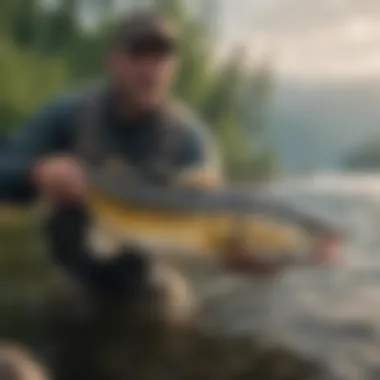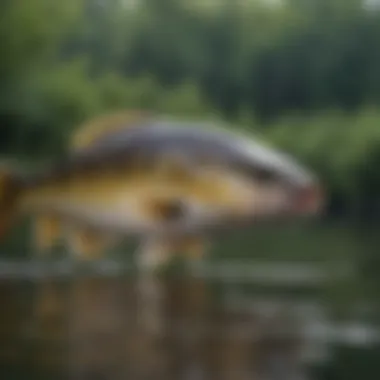Unlocking the Optimal Timing for Walleye Fishing on Lake Erie


Overview of the Topic
Current Status and Challenges
The current state of walleye populations in Lake Erie presents both opportunities and challenges for anglers. The fluctuating water temperatures, changing currents, and environmental factors in the lake significantly impact the movement and behavior of walleye fish, posing challenges for anglers aiming to predict their patterns effectively. Additionally, external threats such as overfishing, habitat loss, and pollution contribute to the complexity of walleye fishing on Lake Erie, highlighting the importance of sustainable fishing practices to maintain the ecosystem's health.
Sustainable Solutions
In response to the challenges facing walleye populations in Lake Erie, sustainable fishing practices have been introduced to promote the long-term health and vitality of the fishery. Initiatives focusing on catch-and-release practices, habitat restoration, and conservation efforts aim to mitigate the impact of overfishing and habitat degradation, ensuring the sustainable management of walleye populations in the region. By implementing these proactive measures, anglers can contribute to the preservation of walleye populations for future generations to enjoy.
Impact and Importance
The impact of walleye fishing on Lake Erie extends beyond recreational purposes, playing a crucial role in the ecosystem and local communities. The conservation of walleye populations is essential for maintaining the biodiversity of the lake, as these fish serve as indicators of ecosystem health. Furthermore, the economic significance of walleye fishing in supporting local businesses, tourism, and cultural heritage underscores the importance of conservation efforts to sustainably manage and protect this valuable natural resource.
Understanding Walleye Behavior
Fish behavior plays a crucial role in successful fishing expeditions, making a profound understanding of walleye behavior imperative for anglers. By comprehending seasonal patterns, temperature preferences, and feeding habits, anglers can strategically plan their fishing trips to maximize their catch. Understanding how walleye behave allows anglers to adapt their techniques and timing accordingly, leading to a more fruitful fishing experience.
Seasonal Patterns
Spring Spawning Season
During the spring spawning season, walleye exhibit unique behaviors crucial for their reproduction. This period, characterized by walleye gathering in specific locations to spawn, presents a prime opportunity for anglers to target these fish. Understanding the signs of spawning activity and preferred spawning grounds can significantly increase chances of catching walleye during this period. Anglers must consider the delicate balance between catching fish and preserving their populations for sustainability.
Summer Feeding Patterns
Summer marks a shift in walleye behavior towards increased feeding activity. Anglers can capitalize on this by targeting areas where walleye are actively feeding, such as near structures or drop-offs. The summer feeding patterns of walleye align with their need to store energy for the upcoming colder months, presenting ample opportunities for anglers to land sizable catches. However, constant monitoring of regulations and conservation practices is essential to prevent overfishing.
Fall Migration
As temperatures decrease in fall, walleye exhibit migratory behaviors to locate optimal feeding grounds. This period often sees walleye moving towards shallower waters in preparation for the winter season. By understanding the triggers that prompt fall migration, anglers can position themselves in strategic locations to intercept these fish. Fall migration provides anglers with a diverse range of fishing opportunities, from shoreline casting to trolling deeper waters.
Temperature Preferences


Impact of Water Temperature on Walleye Movement
Water temperature plays a significant role in dictating walleye behavior, influencing their movement patterns and feeding preferences. Understanding how changes in water temperature affect walleye activity is essential for successful fishing. Warmer waters may push walleye into deeper, cooler areas, while cooler temperatures could drive them towards shallower waters. By leveraging this knowledge, anglers can adjust their fishing tactics to align with walleye movements, increasing their chances of a successful catch.
Feeding Habits
Preferred Prey Species
Walleye are known to have specific preferences when it comes to their prey species, often targeting small fish like minnows, shad, and perch. Understanding the key prey species of walleye enables anglers to select suitable lures and baits that mimic these natural food sources. By presenting bait that closely resembles the preferred prey of walleye, anglers can entice more strikes and increase their catch rates. Additionally, knowledge of preferred prey species aids in conservation efforts by promoting selective and sustainable fishing practices.
Nighttime vs. Daytime Feeding
The feeding behavior of walleye varies between daytime and nighttime, presenting anglers with unique fishing opportunities. While walleye are more active during low-light conditions, such as dawn and dusk, they also feed selectively during the day. Anglers can benefit from understanding these feeding habits by adapting their fishing techniques accordingly. Fishing during the night may require specialized tactics, such as using lights to attract walleye, while daytime fishing involves targeting specific structures or cover where walleye are likely to feed.
Factors Influencing Walleye Activity
In the realm of walleye fishing on Lake Erie, understanding the factors that influence walleye activity is paramount to a successful angling experience. Weather conditions, water clarity, and moon phases all play significant roles in determining when and where walleye are most likely to be active. By delving into these factors, anglers can elevate their fishing game and increase the chances of a fruitful catch. Whether it's analyzing barometric pressure, wind speed, or the moon's phase, paying attention to these elements can make all the difference between a sparse catch and a bountiful haul.
Weather Conditions
Effect of Barometric Pressure:
Barometric pressure, an oft-overlooked yet crucial component of weather conditions, holds sway over walleye behavior in subtle ways. When the barometric pressure rises or falls, walleye tend to adjust their feeding habits and activity levels accordingly. Understanding this aspect allows anglers to anticipate potential shifts in walleye behavior, strategically planning their fishing excursions to coincide with periods of optimal activity prompted by these pressure variations. While the impact of barometric pressure may not always be immediately evident, its influence on walleye movements is undeniable and warrants careful consideration for any serious angler on Lake Erie.
Role of Wind Speed:
Another fundamental aspect of weather conditions that directly affects walleye activity is wind speed. Although often perceived as a mere environmental factor, wind speed plays a significant role in stirring up the water and creating favorable conditions for walleye feeding. With higher wind speeds, walleye are more likely to venture closer to shore in search of disoriented baitfish, presenting anglers with prime opportunities for a successful catch. Moreover, the presence of wind can help conceal angler movements and noises, providing a stealth advantage that can significantly boost fishing outcomes. By recognizing the pivotal role of wind speed in walleye behavior, anglers can adapt their strategies accordingly, maximizing their chances of a rewarding fishing outing.
Water Clarity
Impact on Walleye Feeding Behavior:
The clarity of water in Lake Erie serves as a crucial determinant of walleye feeding behavior, influencing their visibility and hunting tactics. In waters with poor clarity, walleye may rely more on their other heightened senses, such as smell and lateral line detection, to locate prey. Alternatively, in clear waters, they are more visual predators, utilizing their keen eyesight to target prey with precision. Understanding this dynamic enables anglers to adjust their lure presentations and techniques based on prevailing water conditions, increasing the likelihood of enticing walleye strikes. By recognizing the impact of water clarity on walleye feeding behavior, anglers can fine-tune their approach and optimize their fishing success percentages in Lake Erie.


Moon Phase
Influence on Walleye Activity Levels:
The moon's phase exerts a captivating influence on walleye activity levels, dictating periods of heightened feeding and movement. For walleye anglers on Lake Erie, being attuned to the lunar cycle can provide valuable insights into when walleye are most active and susceptible to biting. During full moon phases, walleye tend to display increased activity levels, venturing into shallower waters and exhibiting more aggressive feeding behavior. Conversely, during new moon phases, they may be more cautious and selective in their feeding habits. By aligning fishing trips with favorable moon phases, anglers can significantly enhance their chances of encountering vibrant walleye activity, leading to more memorable and successful outings on the lake.
Optimal Timing for Walleye Fishing
When delving into the realm of walleye fishing on Lake Erie, one cannot undermine the criticality of optimal timing in maximizing the chances of a successful catch. The significance of selecting the right time to embark on a fishing expedition lies in aligning with the natural behaviors and patterns of these elusive fish. Understanding the opportune moments when walleye are most active can greatly enhance the angling experience and increase the likelihood of a fruitful outing. Whether it's the break of dawn, the hush of dusk, or the cover of night, each time segment presents unique opportunities for anglers to hone their skills and reel in the prized walleye.
Early Morning
Benefits of Dawn Fishing
Embarking on a fishing venture during the early hours of the morning, known as dawn fishing, offers a plethora of advantages that enthusiasts cannot overlook. The soft glow of the rising sun creates a tranquil ambiance that is complemented by the heightened activity levels of walleye during this time. Anglers benefit from the increased visibility in the water, allowing for better accuracy in casting and improved chances of attracting nearby fish. Dawn fishing also capitalizes on the feeding patterns of walleye, as they are often more active during these early hours, seeking out their morning meal. The serene atmosphere coupled with the promise of a successful catch makes dawn fishing a preferred choice for anglers looking to kickstart their day with an exhilarating angling experience.
Dusk
Twilight Fishing Strategies
As daylight wanes and dusk descends over the horizon, twilight fishing emerges as a strategic approach to hooking walleye during their transition to nocturnal feeding habits. The subdued light during this period serves as a natural veil, allowing anglers to capitalize on walleye's heightened sensitivity to motion and sound. By employing specialized techniques tailored for low-light conditions, such as slow retrieves and subtle movements, anglers can effectively entice walleye lurking in the shadows. Twilight fishing not only presents a unique challenge for anglers seeking a test of their skills but also offers the potential for rewarding catches as walleye actively forage in preparation for the night ahead.
Night Fishing
Using Lights for Nighttime Walleye Fishing
Venturing into the realm of night fishing unveils a realm of possibilities for anglers eager to explore the nocturnal behaviors of walleye. One essential strategy employed during nighttime walleye fishing involves the strategic use of lights to attract these nocturnal predators. Lights placed above the water surface mimic the effect of moonlight, drawing in plankton and smaller baitfish, which in turn, attract walleye seeking an easy meal. The mesmerizing dance of shadows and light creates an irresistible spectacle for walleye, enticing them to move closer and fall prey to well-presented lures. However, while night fishing offers a chance to target walleye under the shroud of darkness, anglers must exercise caution and adapt their techniques to suit the challenges posed by limited visibility and heightened sensory awareness of these elusive fish.
Tackle and Techniques
When it comes to walleye fishing on Lake Erie, mastering the right tackle and techniques is crucial for a successful angling experience. The selection of appropriate gear and the application of proper fishing methods can make a significant difference in one's ability to catch walleye effectively. Anglers need to consider various factors such as water conditions, depth, and walleye behavior when choosing their tackle and techniques. Selecting the right lure and utilizing the correct fishing approach can greatly enhance the chances of a fruitful fishing outing.
Best Lures for Walleye Fishing


Jerkbaits
Jerkbaits are an essential component of walleye fishing due to their versatility and effectiveness in attracting this species. Their lifelike action mimics injured baitfish, enticing walleye to strike. One key characteristic of jerkbaits is their ability to be twitched erratically, simulating an injured prey fish's movements. This erratic motion triggers aggressive feeding responses from walleye, making jerkbaits a popular choice among anglers. While jerkbaits can be highly productive in enticing walleye bites, their downside lies in their potential to snag on debris or underwater structures.
Jigs
Jigs play a vital role in walleye fishing, especially in situations where a bottom-bouncing presentation is needed. Their weighted head design allows them to sink quickly, reaching the desired depth where walleye often feed. One key characteristic of jigs is their ability to be tipped with live bait or soft plastics, providing anglers with a versatile option to customize their presentation based on the prevailing conditions. Jigs, when properly presented, can closely mimic the natural movement of prey, making them a valuable tool for enticing walleye to bite. However, jigs can be challenging to fish in rocky terrain or areas with heavy vegetation.
Crankbaits
Crankbaits are renowned for their effectiveness in targeting walleye, particularly in covering expansive water bodies efficiently. Their diving lip design enables them to reach different depths, allowing anglers to explore a wide range of fishing zones. One key characteristic of crankbaits is their ability to produce a distinct wobbling action that closely resembles the movement of forage fish. This realistic action triggers the predatory instinct of walleye, making them more likely to strike. While crankbaits excel in covering water quickly and locating active fish, their downside includes potential tangling in weeds or getting caught on underwater obstacles.
Trolling Methods
Downrigging vs. Planer Boards
Choosing between downrigging and planer boards is a crucial decision that can significantly impact walleye fishing success. Downrigging involves using weighted lines to reach desired depths while presenting lures at controlled levels. The key characteristic of downrigging is its ability to precisely target specific depth ranges where walleye are actively feeding. This method is highly effective in locating fish suspended at various depths in open water. On the other hand, planer boards enable anglers to spread out multiple lines laterally behind the boat, covering a broader fishing area. One key characteristic of planer boards is their capacity to troll lures away from the boat's path, minimizing disturbance and increasing the chances of enticing cautious walleye. Each method has its advantages and disadvantages, and the choice between downrigging and planer boards often depends on factors such as water depth, walleye behavior, and angler preference.
Regulations and Conservation
Fishing Regulations on Lake Erie
License Requirements
When it comes to fishing regulations on Lake Erie, delving into the intricacies of license requirements is paramount. License requirements dictate who is eligible to fish in specific areas and contribute to the management of fishing activities to prevent overexploitation of walleye populations. Understanding license requirements is crucial for anglers as it ensures compliance with legal guidelines and fosters sustainable fishing practices. By obtaining the necessary licenses, anglers support conservation efforts and contribute to the overall well-being of the ecosystem.
Limits and Size Restrictions
Examining the limits and size restrictions imposed on walleye fishing in Lake Erie provides valuable insights into conservation measures. Limits and size restrictions aim to control the harvesting of walleye to maintain population levels within sustainable limits. By abiding by these restrictions, anglers play a vital role in preserving the genetic diversity and overall health of the walleye population. Understanding the rationale behind these regulations helps anglers appreciate the importance of responsible fishing practices and underscores the significance of conservation in ensuring the long-term viability of the fishery.
Sustainable Fishing Practices
Catch and Release Techniques
When exploring sustainable fishing practices, delving into catch-and-release techniques offers a glimpse into conservation-oriented angling methods. Catch and release techniques involve returning caught fish back into the water, minimizing the impact on fish populations and promoting the sustainability of the fishery. By employing catch-and-release practices, anglers actively contribute to conservation efforts by reducing fish mortality rates and preserving fish stocks for future generations. Implementing effective catch and release techniques underscores the commitment to ethical angling practices and demonstrates a dedication to safeguarding the walleye population for years to come.
Proper Handling of Walleye
Proper handling of walleye after capture is a critical aspect of sustainable fishing practices that cannot be overlooked. Handling walleye with care ensures the fish's survival post-release and minimizes stress-induced mortality. By understanding the proper techniques for handling walleye, anglers can elevate their conservation efforts and enhance the fish's chances of survival after being caught. Emphasizing proper handling protocols not only showcases a respect for the fish species but also aligns with the broader goal of maintaining a healthy walleye population in Lake Erie. Implementing best practices for handling walleye solidifies the commitment to conservation and underscores the importance of ethical angling practices.



